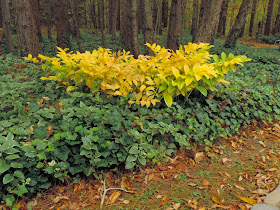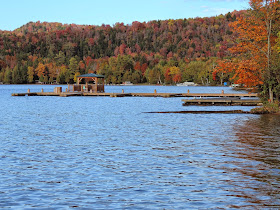There is still a few beautiful trees with their fall foliage to be found, but now a lot of bare trees and trees with brown, dry, crinkly leaves left on them are mostly dominating the landscape.
It's so easy to get distracted when I'm writing an article. I might have to look something up on the internet and then something else piques my interest and I go off on a tangent researching that. I'm easily distracted. Especially when I'm sitting here at the computer and Facebook is running in the background ... so I check Facebook and there are some news headlines I have to read, or comment on a friend's post or picture.
Or if I'm going through photos to upload for my blog post, I come across photos of the grandkids so I have to look at all them. Then I start doing a little editing on the photos. . . and so the story goes.
Oh, and I almost forgot to mention that I'm a procrastinator. My husband, Ted, can attest to that. Actually all my family can. But sometimes good things and ideas can happen and come to me while I'm procrastinating.
Now for some garden thoughts. . .
 |
| Re-blooming daylily: Happy Returns |
 |
| This goldenrod was the only flower blooming in the field across the road from us and the pollinators were flocked to it. |
Planting Chart. Another thing you might decide to do is to make a little planting chart. This might sound like a lot of work, but I found it useful when those garden tags got lost or pulled up. It doesn't have to be an exact science, but it's good to know where things are especially if they are not in bloom. When you have several varieties of perennials like irises, hostas, and daylilies it's good to know where they are. Remember though that when/if you transplant an item you have to change that item on your chart as well.
Lists. I actually created a database on the computer and listed in there the perennials, shrubs, vines, groundcovers, etc. and where I planted them and the place I purchased them. I found this helpful because after purchasing several plants during the year at different places you can forget where you bought them. Then when you find that several items from one nursery didn't make it the next season, you can shop elsewhere. Lists aren't really necessary, but it helps me because if I'm ordering plants I can look at my list and see which ones I already have. This way I'm not ordering duplicates of the same plant. This helps when you have a high number of the same variety of plants like daylilies and irises. I probably have over 50 varieties each of daylilies and irises.
| Was waiting all season to get a photo of a Monarch! Got this one October 2, 2014, in the Adirondack Mountains in N.Y. |
On another list I like to write items down that I would like to do next spring/summer. Such as which perennials need to be transplanted, or divided, or dug up entirely and discarded. I remember reading a garden note that said an old calender can be used as a "garden planner". You can write notes on there when your various plants are in bloom, when you started your seeds, when your plants bloomed, the best time to divide or transplant them, what looked good, and what had diseases/problems.
Mums. Or Chrysanthemums. No wonder they shortened the word to "Mums". Who can spell chrysanthemums. This is the time of year that you see all the beautiful mums in full bloom in colors of yellow, orange, pink, purple and reds. If you purchased some in decorative pots and they are on display now is the time to plant them in the ground. They should/might survive the winter if you get them planted now (before it snows). But don't cut them back. Wait until spring and then cut down the old growth. I usually trim mine back after I see new growth on them in the spring. But actually the best time to plant mums is in the spring. Then their roots have all season to get established before the cold weather. Plant them in a sunny, and well drained area. They need at least three hours of direct sunlight.
To get your mums to bush out (so they don't get tall and flop over), early in the season when the plants are about six inches tall, you can start pinching (or cutting) back the tips of the plant. Pinch off or cut back about one inch on each stem. This will force the stems to produce side branches which in turn will produce more flowers. If you don't want to do this by individually "pinching" the tips take a pair of scissors and clip them back about an inch all the way around the plant. When the plant is about a foot tall, pinch back all the tips again. You can continue pinching the plant back in this manner until about the middle of July then your plant will start to produce flower buds. When the plant dies back in the fall you can mulch it with shredded leaves.
"All those golden autumn days the sky was full of wings. Wings beating low over the blue water of Silver Lake, wings beating high in the blue air far above it. . .bearing them all away to the green fields in the South."
~Laura Ingalls Wilder
 |
| Ted's first chainsaw sculpture! |
Happy Halloween!
Thanks for stopping by. . .
Feel free to leave a comment!





























